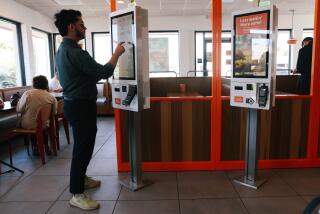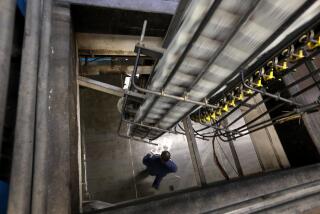A Pressing Matter
- Share via
Dick Lunde recalls the good old days when customers would walk into his Laguna Hills print shop with raw copy, pictures and charts. Skilled printers stitched it all together, and clanking machines would spew out the finished product. But life behind the service counter has changed dramatically. Sophisticated computer technology has sparked the biggest revolution in printing since Johann Gutenberg invented movable type in 1440.
A few of the old mechanical presses still labor at the Sir Speedy franchise shop that Lunde operates in a busy strip shopping center on Lake Forest Road. But sitting next to them are the sleek white computers and scanners that churn out printed documents with nary a sound.
The print shop industry nationwide is being invaded by an army of expensive computerized devices, turning time-tested printing machines into antiques overnight.
“The leading edge of technology can become the bleeding edge for printers,” said Steve Hammerstein, president and chief executive of Houston-based ICED Inc., which operates more than 1,000 print shops.
Lunde believes the rapidly changing technological scene threatens the “very existence of 70% to 80% of all the quick-print shops in the world.”
The reason, industry observers say, is that it is becoming increasingly difficult for independent print shop operators to accumulate the cash and technological savvy needed to successfully ride the wave of change.
For now, the nation’s $10-billion quick print industry is still dominated by mom-and-pop storefronts, some of which do little more than print letterheads and business cards. Big chains and franchise operations account for only 5,800 of 33,000 shops nationwide, according to Quick Printing magazine, a trade publication.
But as competition heats up, many regional players are positioning themselves for the future by building national chains.
The Mission Viejo-based parent company of the Sir Speedy chain crowed that its October 1996 acquisition of Agoura Hills-based PIP Printing created an industry heavyweight with 1,500 locations worldwide and an estimated 30% of the industry’s revenue.
Ventura-based Kinko’s Inc. recently completed a $214-million private offering whose proceeds are being used to ready the 800-unit chain for rapid growth and for a rumored public stock offering.
*
The consolidation bug is biting elsewhere: Minneapolis-based Insty-Prints Inc. used acquisitions to build a 300-unit chain, and ICED has acquired several competitors.
As the quick-print industry consolidates, it’s also feeling heat from several new competitors.
OfficeMax, a leading office products retailer, is converting many of its existing stores to OfficeMax/CopyMax locations, and it’s also opening new OfficeMax/CopyMax stores. The Cleveland-based chain hopes to have 100 of the retail/printing services shops open by 1999.
Equipment manufacturers such as Lanier and Xerox, and office equipment dealers such as Ikon also are entering the fray. With their deep pockets and national sales forces, they’re viewed as powerful competitors for large, national printing accounts.
All this in the Information Age? Wasn’t paper supposed to become obsolete?
Actually, the overall market for printed documents is expected to continue to grow. As the rising pile of faxes, reports, letters and newsletters on your desktop suggests, paper still has a role to play in business and at home. And, futurists say, there will always be a need for paper copies.
Torrance-based Explor International, a nonprofit group that studies the technology used to produce documents, suggests that consumers bombarded with ever-more computer-generated information will continue to want to print many of the most important and interesting documents.
There’s no reason that well-run mom-and-pop shops can’t survive as technology and consolidation reshape the industry, but executives at leading chains suspect that the future for many independents is bleak.
“We expect continued consolidation,” ICED’s Hammerstein said. “Single-shop operations and smaller print systems do not have the resources or the market penetration to take full advantage of the service offerings of digital technology.”
*
Conventional wisdom suggests that the print shop of tomorrow will have to have a global reach--which means being part of an electronically linked chain that can serve a customer’s needs from Laguna Hills to London.
In the old days, said Bob Hall, publisher of Quick Printing, a print shop’s jobs were relatively simple. A customer might order 10,000 hard copies of a sales brochure. When they were printed, the customer stored the brochures in a warehouse, mailing them out as the need arose.
But along with printed copies, customers now are asking that their brochures also be made available to customers on a CD-ROM or via the Internet.
Print shops also are being asked to print documents where they’re needed. With computers and modems, a shop in Southern California can zap information to sister offices in Venezuela, Hong Kong and Paris, where it’s then printed and distributed. This process saves time and cuts postal expenses.
And when the supply of brochures is exhausted--or the document needs to be updated--changes can be painlessly made by computer.
“The implications are very dramatic,” said Explor Executive Director Keith Davidson. “As more customers turn to digital devices, retail print shops will quickly become nodes on a much larger digital network. Even the U.S. Postal Service is desperately trying to catch up with the technological revolution.”
*
Although the printing revolution holds great promise for those able to profit from it, industry experts say the conversion to a digital world has been and will continue to be painful.
About a third of print shop customers now prepare their print jobs on sophisticated computers at home or in their offices, print shop owners say. Consumers assume that delivering the print job on a computer disk or via the Internet will speed production and cut costs.
But many of the print jobs that customers deliver must be redone, Lunde said, because the customer isn’t technically proficient or the print shop doesn’t have compatible equipment.
Print shop owners moan that there’s not yet an industry standard that would push equipment manufacturers into a single-file line. So print shop owners are forced to patch together different formats from different equipment in order to keep pace with customers’ expectations.
And therein lies another impetus toward consolidation: Each of the big chains hopes to gain enough power to force a standard.
“The larger you are, the more likelihood you can control the technological environment,” Davidson said. “The larger you are, the more incentives you can give to customers to accept your standards.”
The new technology can be prohibitively expensive, Lunde said, particularly for shop owners who jump into the digital pool with both feet.
Print shop owners often find they can’t justify hefty price tags associated with the new technology. The blazing speed of $200,000 printing machines, Lunde said, is impressive--but relatively few shop owners have enough customers to justify the expense.
“I preach to anyone who will listen that the vendors are going to sell you anything that they can,” Lunde said. “You can buy these things, but the real question is whether you can make any money with it.”
*
And as customers fire up their desktop publishing systems and explore the Internet, print shop operators are doing their best to show that they’re keeping up.
Arizona-based Alphagraphics, with 330 locations, has filed a 100-page corporate “Netvision” at its Web site to tout its plans for the future. Kinko’s, which even offers facilities for video teleconferencing, has just unveiled Kinkonet, which allows customers to zap their digital files around the world.
But even as the printing revolution moves forward, shop owners are hesitant to throw out older machines that are still cost-effective alternatives.
“We’ve got two kinds of ‘nets’ in our shops,” said Robert Sutter, chief executive of the Insty-Prints chain. “One of them is linked together by cables. The other is linked together by employees who strap on their Nikes and walk eight feet to the next machine. We call it the ‘sneaker net.’ It’s not terribly expensive, but in many cases, it still works real well.”
More to Read
Inside the business of entertainment
The Wide Shot brings you news, analysis and insights on everything from streaming wars to production — and what it all means for the future.
You may occasionally receive promotional content from the Los Angeles Times.









